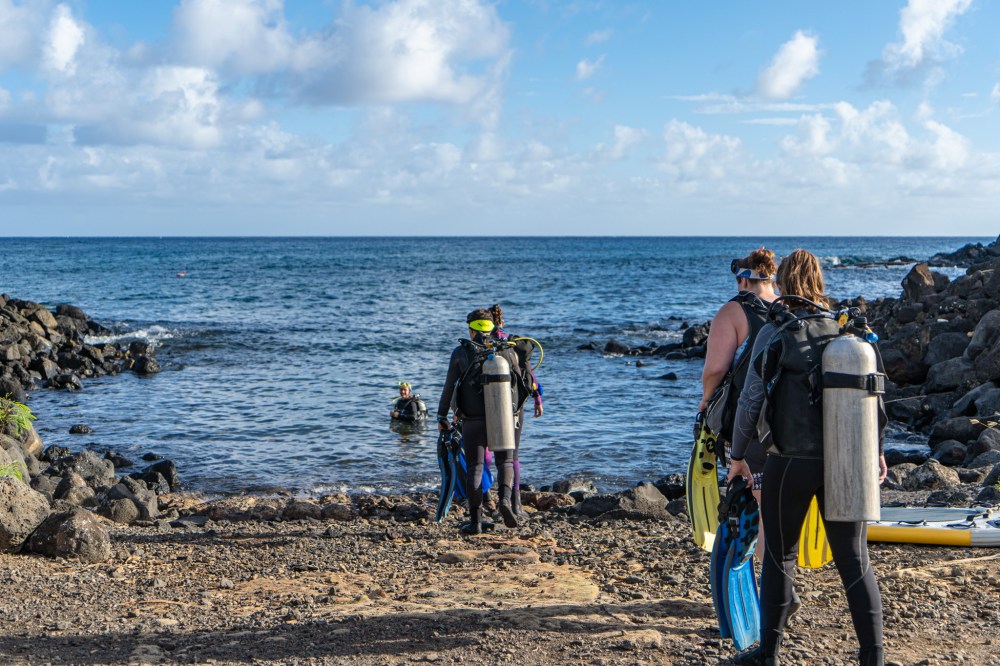Choosing the Best Dive Fins: Tips from Kauai’s Fathom Five
 Choosing the Best Dive Fins: Tips from Kauai’s Fathom Five
Choosing the Best Dive Fins: Tips from Kauai’s Fathom Five
Choosing the right diving fins is a crucial step in gearing up for your underwater adventures. The difference between a good dive and an amazing one can often hinge on your fin selection. The right pair can propel you effortlessly through coral reefs, deep waters, and even icy seas, enhancing your experience with every kick. Conversely, ill-fitting or inappropriate fins can turn a dive into a struggle, detracting from the wonders of the underwater world.
But don’t stress! Fathom Five has put together a comprehensive guide on how to choose the right scuba diving fins just for you. The array of options available to divers today is impressive, ranging from variations in fit and blade design. Each type serves different diving conditions and preferences, and understanding these nuances is key to optimizing your dives. Whether you’re navigating through serene tropical waters or exploring the mysterious depths of a cold ocean, finding the right fins is essential. So, let’s dive deeper into how to make the best choice for you.
Open Heel Fins Vs. Full Foot Fins
Choosing the right dive fins starts with deciding between open heel fins and full foot fins. This choice significantly impacts your diving comfort and performance but often comes down to a simple personal preference.
Open heel fins are designed for versatility and protection, requiring the use of wetsuit booties. These fins are indispensable for colder dive sites and offer additional protection for entering on a shore dive or walking on rough terrain. The adjustable straps ensure a snug fit over the booties, accommodating a wide range of foot sizes and shapes, making them a more adaptable choice for divers who face varied conditions.
Meanwhile, full foot fins shine in warm water conditions, offering simplicity and convenience. Since they’re designed to be worn without booties, there’s less gear to manage, making them a popular choice for divers who often travel to tropical destinations. Their ease of use and reduced need for additional equipment make them ideal for leisurely dives in warmer climates.
Different Types of Scuba Fins
Moving beyond the foundational decision between open heel and full foot fins, we have options for various blade types that divers can choose from. Different blade types match various diving needs and preferences. Most styles come in both open-heel and full-foot options, giving divers a broad choice. Let’s explore these options to find the perfect match for your next Kauai dive.
-
Paddle Fins
Paddle Fins are divers’ long-time trusty companions, having stood the test of time since diving’s earliest days. These are the no-nonsense, get-the-job-done kind of fins. Their straightforward design pushes water directly back, offering divers dependable and effective propulsion.
Benefits:
- Known for their simplicity and effectiveness.
- Provide excellent maneuverability and precise control.
Drawbacks:
- Can be more physically demanding, which might lead to quicker fatigue.
-
Channel Fins
Channel Fins are the artists of the fin world, elegantly sculpting water with each kick. Their design, featuring flexible panels that funnel water efficiently, is meant to allow for graceful, energy-saving movements. With these fins, you glide through the water, conserving energy and extending your underwater exploration.
Benefits
- Enhance propulsion without extra effort, perfect for longer dives.
- Balance power with energy conservation, adaptable across conditions.
Drawbacks
- Softer materials may wear out faster.
- Typically come with a higher price tag due to their advanced design.
-
Vented Fins
Imagine vented fins as the sportscars of the underwater world, equipped with clever engineering that manages the flow of water around them. These fins claim to streamline water flow during the recovery phase of your kick, allowing for less drag and then blocking water during the power stroke, propelling you forward more efficiently.
Benefits
- Offer a smooth and efficient kick, great for extended dive times.
- Provide substantial propulsion and control.
Drawbacks
- Performance can vary based on diving conditions.
- Some divers might prefer the feel of non-vented fins for specific types of diving.
-
Split Fins
Split Fins are the revolutionaries, challenging traditional designs with their innovative split that acts like a propeller blade. They make kicking feel almost effortless, propelling you forward with each kick. Ideal for those who prefer to save their strength for the duration of their dive, these fins are about making every movement count without wearing you out.
Benefits
- Reduce muscle fatigue and oxygen consumption.
- Perfect for divers who value efficiency and ease of use.
Drawbacks
- Reduced speed and power compared to other fins.
- Generally more expensive due to their cutting-edge design.
-
Pivot Blades
Pivot blades, also known as hinged fins, are the innovative adventurers of the fin world, equipped with blades that adjust their angle for optimal propulsion. It’s like having a smart fin that knows exactly how to move to make your kick more effective. They’re perfect for the diver who loves tackling different environments and conditions, from gentle currents to challenging depths.
Benefits
- Ensure maximum efficiency with minimal effort.
- Great for divers who demand versatility and adaptability.
Drawbacks
- May require more maintenance due to their complex design.
- The advanced technology can make these fins more expensive.
 Other Types of Fins
Other Types of Fins
When shopping for fins, you’ll encounter a variety of types that might look similar at first glance, especially to those new to diving. However, it’s essential to recognize that each type is designed with specific activities in mind, vastly differing from one another in function and suitability for certain water environments.
Snorkel Fins
Snorkel fins are shorter and more flexible, making them easy to maneuver in shallow waters. They’re best for surface swimming, offering convenience and reduced fatigue during snorkeling adventures.
Freediving Fins
These are noticeably longer and designed for efficiency, allowing freedivers to dive deep on a single breath. Their length aids in propulsion without excessive effort, essential for the breath-hold techniques in freediving.
Hand Fins
Hand fins, or webbed gloves, augment swimming power by increasing the surface area of your hands. Ideal for surfers, swimmers, and even scuba divers with specific mobility needs, they enhance propulsion across a variety of water sports. For scuba divers, they can offer additional maneuverability and support in navigating underwater environments.
How to Choose the Right Diving Fins For You
Choosing the right diving fins is crucial for enhancing your underwater experience. It involves aligning your gear with how and where you dive, considering more than just fit and aesthetics. By categorizing your preferences and considering how you dive, you can pinpoint the fins that will best support your underwater adventures.
Diving Style Considerations
Tailoring your fin selection to your diving style ensures you have the right support for your chosen activities, environments, and personal preferences. Key factors include:
-
Water Temperature: Cold vs. Tropical
- Cold Water Diving: Requires open heel fins worn with thick booties for insulation. Stiff fins might be preferred for their power in combating strong currents.
- Tropical Water Diving: Full-foot fins are ideal for warm waters, offering comfort and ease of use without the need for booties.
-
Diving Conditions: Currents vs. Calm
- Strong Currents: Look for fins that provide powerful propulsion, likely stiffer models, to help you navigate through currents with ease.
- Calm Waters: Flexible fins are suitable for leisurely dives in calm conditions, allowing for a more relaxed flutter kick.
-
Dive Activities: Recreational vs. Technical
- Recreational Diving: Flexibility and comfort are key. Lightweight and easy-to-kick fins enhance the casual diving experience.
- Technical Diving: Precision and power are crucial. Opt for stiffer fins with strong thrust capabilities and durable strap options.
-
Travel Considerations
- If you’re a frequent traveler, consider the weight and size of the fins. Compact and lightweight fins are easier to pack, with full foot fins often being the more travel-friendly option.
Stiff vs. Flexible Fins
Next, the choice between stiff and flexible fins is influenced by your dive profile and personal preferences:
- Stiff Fins: Best for divers needing power and control in challenging conditions, such as cold water and strong currents.
- Flexible Fins: Suited for longer, leisurely dives in calm and warm waters, where efficiency and comfort are prioritized.
Fin Strap Attachment Options
It’s also essential to consider how your fins attach, as this can affect both convenience and fit:
- Buckle Straps: Traditional and adjustable, suitable for divers who prefer custom fit adjustments.
- Spring Straps: Provide ease of use and durability, perfect for divers seeking quick and secure fitting without adjustments.
- Quick-Release Straps: Offer the utmost convenience for quick fitting and removal, ideal for divers on the go or those diving in challenging conditions where quick gear changes are needed.
By carefully considering your dive profile, including the water temperature, diving conditions, activities, and travel needs, and then matching these with the appropriate fin strap options and stiffness, you’ll find the perfect pair of fins. This tailored approach ensures your diving fins enhance your experience, allowing you to explore the underwater world with comfort, efficiency, and joy.
Expert Guidance and Premium Gear at Fathom Five
As you prepare for your next epic adventure, Fathom Five is here to guide you in selecting the ideal fins for your dive or to provide the high-quality rental equipment you need. Whether you’re here visiting to explore the vibrant coral reefs of Kauai or gearing up to embark on adventures outside of Hawaii, our expertise and top-tier gear ensure your dive is seamless and unforgettable.
Visit our store for help choosing the perfect diving fin, or schedule a dive with Fathom Five today!
